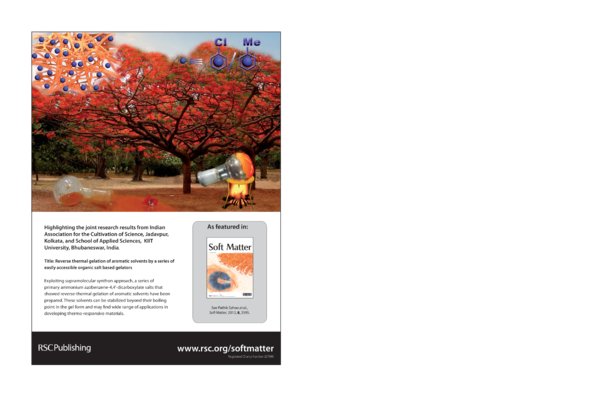Reverse Thermal Gelation of Aromatic Solvents by a Series of Easily accessible Organic Salt Based Gelators|
Reverse Thermal Gelation of Aromatic Solvents by a Series of Easily accessible Organic Salt Based Gelators|
Journal:
Year:
Abstract:
Exploiting crystal engineering and supramolecular synthon concepts, a series of new gelator salts based on primary ammonium dicarboxylate (PAD) salts of azobenzene-4,4′-dicarboxylic acid and primary alkyl amines have been synthesized and characterized by various physico-chemical techniques. Most of the salts were shown to form gels with various solvents. Interestingly, most of the gelator salts possessed rarely observed reverse-thermal gelation (gelation with the rise of temperature) ability of aromatic solvents which may be relevant in developing thermo-responsive materials.
DOI:
10.1039/C2SM06957A
Type of document:
Language:
C
Soft Matter
Dynamic Article Links <
Cite this: Soft Matter, 2012, 8, 2595
PAPER
www.rsc.org/softmatter
Downloaded by University of St Andrews Library on 26 September 2012
Published on 23 January 2012 on http://pubs.rsc.org | doi:10.1039/C2SM06957A
Reverse thermal gelation of aromatic solvents by a series of easily accessible
organic salt based gelators†
Pathik Sahoo, Indrajit Chakraborty‡ and Parthasarathi Dastidar*
Received 13th October 2011, Accepted 12th December 2011
DOI: 10.1039/c2sm06957a
Exploiting crystal engineering and supramolecular synthon concepts, a series of new gelator salts based
on primary ammonium dicarboxylate (PAD) salts of azobenzene-4,40 -dicarboxylic acid and primary
alkyl amines have been synthesized and characterized by various physico-chemical techniques. Most of
the salts were shown to form gels with various solvents. Interestingly, most of the gelator salts possessed
rarely observed reverse-thermal gelation (gelation with the rise of temperature) ability of aromatic
solvents which may be relevant in developing thermo-responsive materials.
Introduction
Supramolecular synthon, originally coined by Desiraju,1 is a wellstudied and accepted tool in supramolecular chemistry2 in
general and crystal engineering3 in particular for designing
desired supramolecular materials.4 By analogy, supramolecular
synthon plays the same pivotal role in supramolecular synthesis
as synthon does in covalent organic synthesis.5 Among the
various supramolecular materials that have been synthesized
using the supramolecular synthon approach,6 low molecular
weight organic gelators (LMWGs)7 are important due to their
various potential applications such as in the field of electrooptics/
photonics,8 sensors,9 cosmetics,10 structure directing agents,11
conservation of art,12 drug delivery,13 and bio-medical applications,14 catalysis15 etc. LMWGs (molecular weight
Coments go here:
- Log in to post comments

